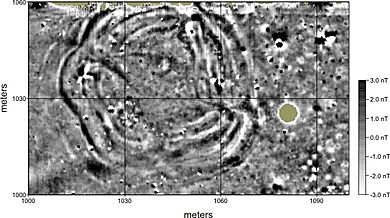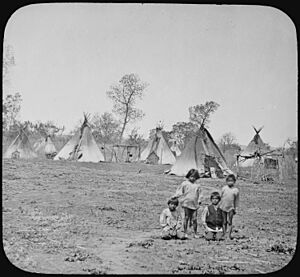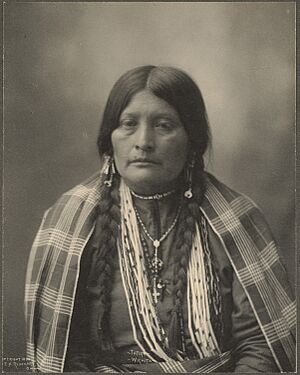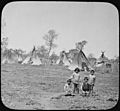Wichita people facts for kids
| Kitikiti'sh | |
|---|---|
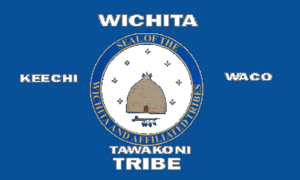
Tribal flag
|
|
| Total population | |
| 2,953 (2018) | |
| Regions with significant populations | |
| United States (Oklahoma, formerly Kansas and Texas) |
|
| Languages | |
| English, formerly Wichita and Kichai | |
| Religion | |
| Native American Church, Christianity, Indigenous religion |
|
| Related ethnic groups | |
| Caddo, Pawnee, Arikara, Kichai, Caddoan Mississippian culture |
The Wichita people, also known as Kitikiti'sh, are a group of Native American tribes from the Southern Plains. Long ago, they spoke the Wichita language and Kichai language. Both of these are part of the Caddoan languages family. Their original homelands were in what is now Oklahoma, Texas, and Kansas.
Today, the Wichita tribes include the Kichai people, Waco, Taovaya, Tawakoni, and the Wichita proper (or Guichita). They are officially recognized by the United States government as the Wichita and Affiliated Tribes (Wichita, Keechi, Waco and Tawakoni).
Contents
Wichita Tribal Economy
The Wichita tribe runs several businesses. These include the Sugar Creek Casino, different restaurants, and the Sugar Creek Event Center in Hinton. They also own a smoke shop, a travel stop, and a history center in Anadarko. In 2010, their businesses added $4.5 million to the economy each year.
Wichita Culture and Lifestyle
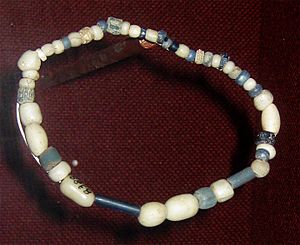
The Wichita language is closely related to the Pawnee language. This shows how connected these two groups were in their culture.
The Wichita people lived in settled villages. Their homes were dome-shaped lodges made of grass, sometimes as wide as 30 feet. The Wichita were skilled hunters, farmers, traders, and negotiators. Their lands once stretched from San Antonio, Texas, all the way north to Great Bend, Kansas. They were a semi-nomadic people, meaning they stayed in one place for part of the year. In the early 1700s, they lived in northern Texas. They traded with other Southern Plains Indians along the Red River and south towards Waco.
Wichita people created their own art, including pottery. French and Spanish traders were very interested in their ceramic pots. Wichita pottery looked very similar to that made by the Osage and Pawnee tribes.
For most of the year, the Wichita lived in huts made from cedar poles covered with dry grasses. In winter, they followed the American bison (buffalo) herds for hunting. During this time, they lived in temporary hunting camps. Bison were very important to the Wichita. They used every part of the animal for clothing, food, shelter, tools, medicine, and even armor. Each spring, Wichita families returned to their villages to plant crops. Over time, horses became very important. More horses in the mid-1600s helped the Wichita hunt for longer periods and work together more as a community. The Wichita also grew crops, gathered roots, and collected fruits and nuts.
Wichita clothing was made from tanned animal hides. Women prepared and sewed these hides. They often decorated their dresses with elk teeth. Both men and women tattooed their faces and bodies with lines and circles.
The Wichita often married and formed alliances with other groups. Wichita women worked with Pueblo people to harvest crops and trade goods. Pueblo women sometimes married Wichita men and lived in Wichita villages.
Wichita society was organized by the rank of each tribe. Each tribe was also led by two chiefs.
Wichita Names and Meanings
The Wichita tribes call themselves Kitikiti'sh or Kirikirish. This means "raccoon-eyed people." It refers to their old custom of tattooing marks around their eyes. The Pawnee, who were related to them, called them Kírikuuruks or Kírikuruks, meaning "bear-eyed people." The Arikara called them Čirikuúnux, also referring to their tattoos. The Kiowa called them Thoe-Khoot, meaning "tattoo faces."
Wichita Tribal Groups
The Wichita people were a loose group of related tribes on the Southern Plains. These included the Taovayas (Tawehash), Tawakonis, Wacos, and the Guichitas (Wichita Proper). Smaller groups like the Akwits, Itaz, Kishkat, and Korishkitsu were also part of this confederation. The Taovaya were the most important group in the 1700s. The French called the Wichita people Panis Piqués (Pawnee Picts) or Panis Noirs (Black Pawnees) because of their tattooing.
Wichita Language
The Wichita people had one main language system. There were only small differences in how it was spoken, depending on where each tribe lived. Since it came from the Caddoan language, much of the Wichita language was very similar to the languages of tribes they were allied with.
Wichita Cultural Centers
In 2018, the Wichita Tribes opened the Wichita Tribal History Center in Anadarko. This center shares the history, archaeology, art, and culture of the Wichita people with everyone.
The Wichita Annual Dance, a powwow, happens every August. It takes place at the Wichita Tribal Park, located north of Anadarko on US-281.
Wichita Historical Sites
Many historical sites of the Wichita people are found across the United States. These sites are located along the Red River in Oklahoma and Texas. They contain old items like pottery, arrows, knives, clay figures, and European trade goods. Digging at these sites has shown large ceremonial and burial structures. These were common in the Wichita territory and culture.
Wichita History
Wichita Before European Contact
After the man and woman were made they dreamed that things were made for them, and when they woke they had the things of which they had dreamed... The woman was given an ear of corn... It was to be the food of the people that should exist in the future, to be used generation after generation. —Tawakoni Jim in The Mythology of the Wichita, 1904
The ancestors of the Wichita people lived in the eastern Great Plains for at least 2,000 years. Their lands stretched from the Red River in Arkansas north to Nebraska. Early Wichita people were hunters and gatherers. Over time, they slowly started farming. Farming villages began around 900 CE. These were built on high ground above the Washita and South Canadian Rivers in what is now Oklahoma.
The women in these communities grew different kinds of corn, beans, and squash. These are known as the Three Sisters. They also grew marsh elder and tobacco, which was important for religious ceremonies. The men hunted deer, rabbits, turkey, and mostly bison. They also caught fish and collected mussels from the rivers. These early villagers lived in rectangular houses with thatched roofs.
Archaeologists describe the Washita River Phase from 1250 to 1450. During this time, more people lived in the area. Villages with up to 20 houses were found every few miles along the rivers. These farmers might have met people from the Panhandle culture villages. These were farming villages along the Canadian River in the Oklahoma and Texas Panhandles. The Panhandle villagers seemed to adopt some cultural traits from the Pueblo peoples of the Rio Grande Valley, with whom they traded.
By the late 1400s, most of these Washita River villages were left empty. No one knows exactly why this happened.
Great Bend Settlements and Council Circles
Many old sites in central Kansas near the Great Bend of the Arkansas River are similar. They are known as the "Great Bend aspect." These sites date from about 1450 to 1700 AD. Experts believe these Great Bend sites are where the Wichita people lived before European explorers arrived. Finding a few European items like chain mail and iron axe heads at these sites suggests early contact with Spanish explorers.
The people of the Great Bend aspect got their food by farming, hunting, gathering, and fishing. Their villages were on high ground near rivers. They likely grew crops on the rich land below. Their main crops were maize, beans, squash, and sunflowers. They also gathered walnut and hickory nuts, plums, hackberries, and grapes. Animal bones found at these sites include bison, elk, deer, pronghorn, and dog. Dogs were one of the few domesticated animals on the Plains before Europeans arrived.
Some village sites have remains of unusual structures called "council circles." These were in the middle of the settlements. They had a central open area surrounded by four structures built partly underground. No one is sure what these council circles were for. One idea is that they were ceremonial places, perhaps used to watch the sun's position during the solstice. Another idea is that important leaders used them. Some archaeologists also think they might have been for defense.
One of these sites was the city of Etzanoa. It was located near present-day Arkansas City, Kansas, by the Arkansas River. This city was active between 1450 and 1700.
Wichita After European Contact
In 1541, the Spanish explorer Francisco Vásquez de Coronado traveled east from the Rio Grande Valley. He was looking for a rich land called Quivira. In Texas, Coronado met people he called Teyas. These people might have been related to the Wichita. He then found Quivira and the people later known as the Wichita near Lyons, Kansas. Coronado was disappointed because he found no gold or silver. The Quivirans were successful farmers and hunters. There were about 25 villages, each with up to 200 houses. Coronado described them as "large people of very good build." He was impressed with the land, calling it "fat and black." Even though Coronado was impressed, he often treated the Wichita poorly. Some Wichita settlements might have stayed in northern Quivira until 1680.
It was also noted that the Quivirans "eat meat raw/jerky like the Querechos [the Apache] and Teyas. They are enemies of one another...These people of Quivira have the advantage over the others in their houses and in growing of maize."
The Quivirans likely called their land Tancoa, which sounds like the later Tawakoni tribe. A nearby area on the Smoky Hill River was called Tabas, similar to the Taovayas tribe. Settlements existed here until the Wichita were forced to leave in the 1700s.
Sixty years after Coronado, Juan de Oñate, who founded New Mexico, visited Etzanoa, a Wichita city. Oñate traveled east from New Mexico, crossing the Great Plains. He met two large groups: the Escanjaques (possibly Yscani) and the Rayados, who were almost certainly Wichita. The Rayado city was probably on the Walnut River near Arkansas City, Kansas. Oñate said the city had "more than twelve hundred houses," meaning about 12,000 people. His description of Etzanoa was similar to Coronado's of Quivira. The homes were spread out. Houses were round, covered with grass, and surrounded by large storage buildings for corn, beans, and squash. Oñate's Rayados were definitely Wichita, probably the group later known as the Guichitas.
The expeditions of Coronado and Oñate showed that the Wichita people in the 1500s were many and lived in a wide area. They were not one single tribe but several related tribes speaking a similar language. Their spread-out villages likely meant they didn't fear attacks much. However, this would change as they became caught between the Apache in the West and the powerful Osage in the East. European diseases probably also caused a big drop in the Wichita population in the 1600s.
In 1719, French explorers visited two Wichita groups. Bernard de la Harpe found a large village near what is now Tulsa, Oklahoma. Claude Charles Du Tisne found two villages near Neodesha, Kansas. La Harpe noted that the Wichita people "had little" religion, but he learned they worshipped a Great Spirit. Coronado's Quivira was abandoned in the early 1700s, likely due to Apache attacks. The Rayados of Oñate were probably still living near the Walnut River. Archaeologists have found a Wichita village from the 1750s at the Deer Creek Site in Oklahoma. By 1757, it seems all the Wichita had moved south to the Red River.
The most important Wichita group was the Taovayas. In the 1720s, they moved south from Kansas to the Red River. They built a large village on the north side of the river at Petersburg, Oklahoma, and on the south side at Spanish Fort, Texas. They adopted many ways of the nomadic Plains Indians. They were known for raiding and trading. They had a strong alliance with the French. In 1746, a French-arranged alliance with the Comanche helped the Wichita prosper again. The village at Petersburg was a busy trading center. Comanches brought Apache slaves, horses, and mules to trade for French goods like powder, knives, and cloth. They also traded for Taovaya-grown corn, melons, pumpkins, squash, and tobacco.
The Spanish called the Wichita and their Comanche allies the Norteños (Northerners). In 1759, the Wichita and Comanche attacked a Spanish military group. Later, the Spanish and their Apache allies tried to punish the Indians for destroying the San Saba Mission. Their army of 500 men attacked the twin villages on the Red River. But they were defeated by the Wichita and Comanche in the Battle of the Twin Villages. The Spanish army lost 19 men and left two cannons behind.
The alliance between the Wichita, especially the Taovayas, and the Comanche began to weaken in the 1770s. The Wichita wanted a better relationship with the Spanish. Taovaya power in Texas dropped sharply after an epidemic, probably smallpox, in 1777 and 1778. This disease killed about one-third of the tribe. After the United States gained their territory in 1803 (the Louisiana Purchase) and Texas became independent in 1836, all the related tribes were grouped together as "Wichita." This also included the Kichai of northern Texas, who spoke a different but related language.
In the 1830s, the main Wichita village was near the Wichita Mountains in Oklahoma. However, the Tawakoni and Wacos still lived in Texas. They were moved to a reservation on the upper Brazos River. In 1859, they were forced out of Texas to a reservation in Oklahoma. During the Civil War, the Wichita sided with the Union. They moved to Kansas, where they built a village at the site of present-day Wichita, Kansas. In 1867, they were moved to a reservation in southwest Indian Territory (now Oklahoma). Most of them still live there today. On June 4, 1891, the tribes signed an agreement to divide their land into individual plots.
Wichita Relationships with Other Tribes
The Wichita usually had peaceful and cooperative relationships with other tribes. They were allies with the Comanche and traded with them. However, they were enemies with groups like the Pawnee, Missouri, and Apache. The Apache were the Wichita's biggest enemies. They had even driven the Wichita out of their homes before Europeans arrived.
The Wichita people's relationship with the Osage is not entirely clear. It is described as "cautiously hostile." Many Osage groups attacked them in the 1700s, eventually forcing them out of the Arkansas River Basin.
Wichita Trade with Europeans
Because of their location, it was hard for the French and Spanish to trade with the Wichita. The French mainly traded with the Wichita for their horses in the 1500s. The Wichita felt that trading with the French was a good idea. Their move in 1714 was partly because they wanted to be closer to European traders.
The Wichita first got European goods in the mid-1700s. This made them want to keep strong ties with the French in the 1800s. French traders were eager to exchange their goods with Wichita settlements as they traveled from Louisiana to Santa Fe.
Wichita Population Changes
The Wichita had a large population when Coronado and Oñate explored. One expert thinks there were as many as 200,000 of them. Villages often had about 1,000 to 1,250 people. So, they certainly numbered in the tens of thousands. Their numbers seemed much smaller by the time the French first met them in 1719. This was probably due to epidemics of infectious diseases. The Wichita had no natural immunity to these diseases. In 1790, it was estimated there were about 3,200 Wichita in total. Conflicts with Texans in the early 1800s and Americans in the mid-1800s led to a big drop in population. This caused Wichita settlements to merge. By 1868, only 572 Wichita were recorded. By the 1937 census, only 100 Wichita were officially left.
In 2018, 2,953 people were officially part of the Wichita and Affiliated Tribes. In 2011, there were 2,501 enrolled Wichitas. Of these, 1,884 lived in Oklahoma. To be enrolled in the tribe, a person needed to have at least 1/32 Wichita ancestry.
Notable Wichita People
- Big Eyes (born around 1520 – after 1542), an enslaved person who guided Coronado's expedition.
- Doris McLemore (1927–2016), the last person to speak Wichita as their first language.
- Cara Jade Myers, an actress.
Images for kids
-
Trade beads found at a Wichita village site, c. 1740, collection of the Oklahoma History Center
See also
 In Spanish: Wichita (tribu) para niños
In Spanish: Wichita (tribu) para niños


